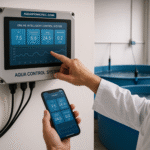1. Why is a Control Box Essential in RAS?
✅ Centralized Control – Manages pumps, aerators, heaters, UV, ozone, and alarms from one place.
✅ Prevents Human Error – Automates critical processes (e.g., oxygen backup during power failure).
✅ Energy Savings – Optimizes equipment runtime (e.g., turns off pumps when not needed).
✅ Safety Protection – Circuit breakers & surge protectors prevent electrical hazards.
✅ Remote Monitoring – Advanced systems allow smartphone/PC control.2. Types of RAS Control Boxes
A. Basic Manual Control Box
For: Small RAS, backyard systems.
On/off switches for pumps & aerators.
Basic timers for lights/feeders.
No automation (requires manual adjustments).
B. Semi-Automated (PLC-Based) Control Box
For: Medium-sized RAS (e.g., tilapia, shrimp farms).
PLC automates equipment based on simple rules (e.g., “If O₂ < 5 mg/L → Turn on aerator”).
Alarms for critical failures (power loss, pump failure).
C. Smart IoT Control Box (AI + Cloud Monitoring)
For: Large commercial RAS (e.g., salmon, high-density systems).
AI adjusts O₂, feeding, and filtration in real-time.
Remote control via smartphone (e.g., adjust pH dosing from anywhere).
Predictive maintenance (alerts before pumps fail).
3. Must-Have Safety Features
⚠ Emergency Stop Button – Instantly cuts power in case of failure.
⚠ Ground Fault Protection – Prevents electrocution in wet environments.
⚠ Backup Battery – Keeps critical systems (O₂, alarms) running during outages.
⚠ Waterproof Enclosure (IP65+) – Protects electronics from humidity/splashes.
aquaponictec.com
Why is a Control Box Essential in RAS?
An Electrical Control Box (or Control Panel) is the central hub that automates and monitors all electrical equipment in a Recirculating Aquaculture System (RAS). It ensures smooth operation, safety, and energy efficiency while reducing manual labor.

